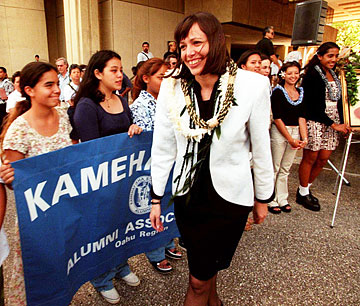LEGACY BETRAYED

HOME | INTRODUCTION | FOREWORD | CHAPTERS 5 & 8 | TIMELINE
TIMELINE
Compiled from the book "Broken Trust" by Samuel P. King and Randall W. Roth
Tracking the trust

BISHOP MUSEUM COLLECTION
Charles Reed Bishop and Bernice Pauahi Bishop, traveling in San Francisco in 1875.
|
|
Princess Bernice Pauahi Bishop dies on Oct. 16 at age 52 . She leaves 378,569 acres of land in trust, under the stewardship of Charles R. Bishop, Samuel M. Damon, Charles M. Hyde, Charles M. Cooke and William O. Smith, all annexationists. Her will instructs them to build Kamehameha Schools, and to prefer Hawaiians when providing support and education to orphans and indigents.
1893
After the overthrow of the Hawaiian monarchy, Kamehameha students and parents vote with their feet against a school run by annexationists. Enrollment drops by almost half.
1916
» Alumnus Charles E. King and nine classmates (Class of 1891) criticize Kamehameha Schools, saying educational standards must be raised to prepare graduates for college or responsible positions in business.
» Probate Judge Clarence Ashford appoints Charles E. King as the first Bishop Estate trustee of Hawaiian descent, rejecting the Supreme Court's choice of haole businessman William Williamson. The Supreme Court overrules Ashford, saying its selection of Williamson is legal and proper, because justices had acted "unofficially" as citizens.
1923
Trustees hire Frank Midkiff as president to raise academic standards. The number of applicants and their test scores rise, along with the school's academic reputation.
1943
Two Hawaiian senators, William Heen and David Trask, criticize changes made under Midkiff. They want Kamehameha to reach more Hawaiians, especially those most at risk. Heen and Trask say trustees are acting like "landed barons," getting big fees while treating Hawaiians like beggars. They manage to pass a law to hold down trustee fees.
1949
Total enrollment at Kamehameha Schools reaches 1,000 students.
1959
Hawaii becomes the 50th state, mass tourism begins and land values climb. The Bishop Estate charitable trust is at the center of one of the hottest real estate markets in the world, owning one in every nine acres in the state.
1961
» Trustees rethink Kamehameha Schools' mission, positioning it to produce leaders. Schools return to a highly selective admissions policy and limit enrollment.
» "Extension" programs are set up to reach other Hawaiians, and serve 6,000 children by the mid-1960s.
1963
Hawaiians march against proposed legislation that would force Bishop Estate and other large landowners to sell their land to the people who own homes on it. The bill fails.
1967
Law is passed allowing homeowners on leased land to buy that land against the owners' wishes. The bill is opposed by Bishop Estate, but its coffers swell as a result.
1970s
Kokua Kalama "people power" protests erupt against development of Bishop Estate land in Hawaii Kai, which is displacing farmers and poor Hawaiians.
1971
» Protests break out when Matsuo Takabuki, a political insider favored by Gov. Jack Burns, is named as Bishop Estate trustee.
» The Ad Hoc Committee for a Hawaiian Trustee, with Samuel P. King as attorney, presses unsuccessfully for Takabuki's removal and changes in the way trustees are selected.
» Trustees allow Takabuki to handle asset management and investing, instead of making joint decisions as a board as required by the will and law.
1990
Deadlock among Supreme Court justices over Big Island businessman Larry Mehau as a potential trustee leads to the appointment of Oswald Stender.
1993
Marion Mae Lokelani Lindsey joins Bishop Estate board, and is named lead trustee for education. She sets up an office on campus, calling shots on the budget and curriculum, and undercutting President Michael Chun.
1994
Supreme Court justices make Gerard Jervis a Bishop Estate trustee, bypassing the candidates recommended by the justices' own blue-ribbon panel.
1995
Trustees approve "Go Forward" plan to build new schools on neighbor islands and expand preschools, but cut extension programs. Fourteen percent of Bishop Estate's workforce is laid off.
1997
» Kamani Kualaau, student body president, and James Moniz, senior class president, write a letter to Supreme Court justices supporting school President Michael Chun and asking the court to intervene. Lokelani Lindsey summons Kualaau for a scolding.
» Kamehameha alumni and supporters march from the Royal Mausoleum to the Supreme Court and Bishop Estate headquarters, asking that management of the schools be returned to Michael Chun.
» Alumni and Kamehameha ohana form Na Pua a Ke Alii Pauahi, the Children of Princess Pauahi, and try to meet with trustees to resolve concerns.
» Teachers at the school band together as Na Kumu o Kamehameha, risking their jobs as they blast the trustees in a public statement.
» Prominent community members write an essay, "Broken Trust," that runs in the Honolulu Star-Bulletin, lambasting Bishop Estate trustees and the political and judicial system that allows them to operate with impunity.
» Gov. Benjamin Cayetano instructs Attorney General Margery Bronster to investigate Bishop Estate and the issues raised in "Broken Trust."
» Court-appointed Master Colbert Matsumoto submits his preliminary report charging that trustees are failing to comply with the law and the princess's will.
» Star-Bulletin publishes "Broken Trust II," by education experts with ties to Kamehameha Schools, who decry "gross mismanagement" under Lokelani Lindsey.
» Patrick Yim, the fact-finder named by the trustees, files a report calling Lindsey's behavior abusive and arbitrary. He meets with trustees to seek Lindsey's resignation, but is rebuffed.
» Four of the five Supreme Court justices announce they will no longer select Bishop Estate trustees.

STAR-BULLETIN / 1997
Members of the Kamehameha ohana pass Iolani Palace on their way to Kawaiahao Plaza on May 15, 1997, to present their grievances to the trustees.
|
|
» Bill limiting trustee pay to "reasonable compensation" passes the Legislature.
» Matsumoto's final report highlights violations of the will and trust law.

STAR-BULLETIN / 1998
Former state Attorney General Margery Bronster walks past Kamehameha students at a rally to show their support for her request to oust the Bishop Estate trustees.
|
|
» Attorney General Margery Bronster and Na Pua call for removal of five trustees. Judge Colleen Hirai announces that she will not remove any trustee without a full trial.
1999
» Internal Revenue Service threatens to revoke the trust's tax-exempt status for gross abuse, saying it looks more like "a personal investment club" than a charity. It calls for resignation or removal of all five trustees.
» Judge Kevin Chang appoints "special purpose" trustees to deal with the IRS, later naming them interim trustees.
» Judge Bambi Weil removes Lindsey permanently. Chang accepts Stender's temporary resignation and removes the other trustees temporarily.
» Gerard Jervis resigns, followed by Stender, Richard "Dickie" Wong and eventually Henry Peters.
2000
» Deputy attorneys general ask Chang to surcharge the former trustees more than $200 million.
» Chang approves a "global settlement" in which the former trustees admit no wrongdoing and don't have to pay surcharges, damages or restitution. He orders the file sealed.
» Chang announces a process by which the probate judge, with the help of a screening committee, will select trustees. Two of the interim trustees, Robert Kihune and Constance Lau, stay on the job and Diane Plotts, Nainoa Thompson and Douglas Ing are named as new trustees.
2002
A panel of substitute Supreme Court justices throws out criminal indictments against Peters and Wong.
2004
Lokelani Lindsey serves six months in federal prison for bankruptcy fraud.
2005
In a 2-1 decision, the Ninth Circuit Court of Appeals rules that Kamehameha Schools' "preference" for Hawaiians acts as a bar to non-Hawaiians. Tens of thousands of Hawaiians march in protest and trustees vow to fight the ruling.
2006
The Ninth Circuit agrees to reconsider the case before 15 judges on the court.
|
WANT TO COMMENT?
The Star-Bulletin welcomes reader responses to this week's excerpts from the new book "Broken Trust: Greed, Mismanagement and Political Manipulation," by federal Judge Samuel P. King and trust law professor Randall W. Roth.
A selection of the responses we receive by this Thursday will be published in the Insight section next Sunday, March 5. We prefer letters of no more than 200 words, but longer responses also will be considered for publication. Letters must include the writer's name, address and daytime telephone number.
Send letters to:
» E-mail: letters@starbulletin.com
» Fax: 808-529-4750
» Mail: Letters to the Editor, Honolulu Star-Bulletin,
7 Waterfront Plaza, 500 Ala Moana, Suite 210,
Honolulu, HI 96813
|

